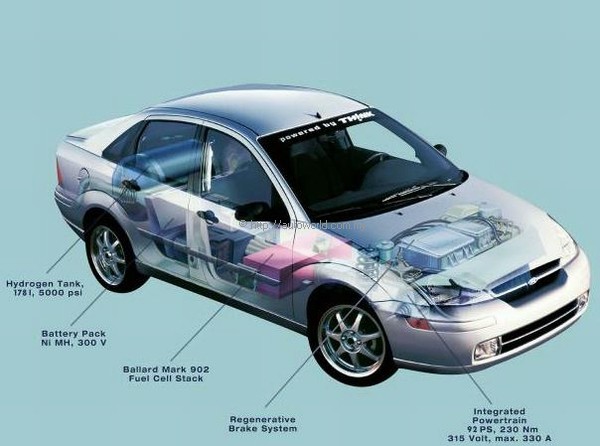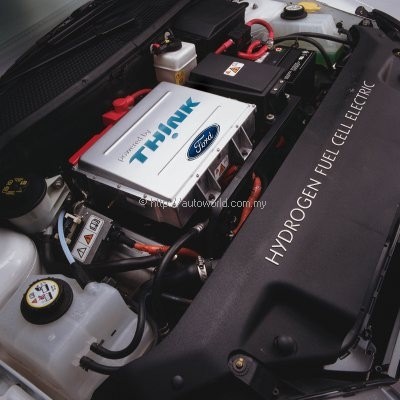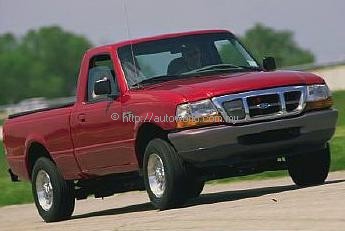Ford Supports ‘Clean Air for Asian Cities’ Initiative
As Ford Motor Company celebrates its 100th anniversary, the company has reaffirmed its pledge for a “better world” through its support for the Clean Air Initiative for Asian Cities (CAI-Asia), whose main role is to promote and demonstrate innovative ways to improve the air quality of cities in South Asia, South-East Asia, East Asia through partnerships and sharing experiences.
CAI-Asia’s brings together relevant stockholders from government, the private sector, and civil society that have an interest in improving air quality in major cities in Asia, as well as international development agencies, internationally organized NGOs and multinationals, that share in the commitment to assist cities in Asia to address their air quality concerns.
Speaking at the launch of Policy Guidelines for Reducing Vehicle Emissions in Asia at the CAI-Asia Executive Council Meeting recently, Ford Motor Company’s Government Affairs director, Liam Benham said: “It is most timely that Ford will celebrate its 100th anniversary on June 16th. In terms of economic and social influence, there aren’t many other companies with a greater impact on the lives of people around the world in the 20th century than Ford.”
“Ford literally put the world on wheels by mass-producing simple, reliable vehicles that the average family could afford. Our goal is to build on these traditional strengths and re-define them for the 21st century. In short, our vision for the future is simple: We’re going to build great products, a strong business and a better world,” Benham continued.
“Ford has conscientiously led the industry in voluntarily pledging to make all of our vehicles cleaner and safer, often well in advance of legislative requirements. Therefore, it is no surprise that Ford is proud to be associated with CAI-Asia in its efforts to improve the air quality for future generations.”
In accomplishing CAI-Asia’s objectives, it is imperative for regional cooperation and communication, and the sharing of best practices and key learnings; in order to effectively influence government policies and regulatory frameworks, as well as the implementation of better air-quality management programs and promotion of new technologies.
“Ford recognizes the importance of cooperation and in building partnerships. We acknowledge the responsibility and the value of our contributions as a global leader in environmental vehicles towards achieving a cleaner air environment,” added Benham.
In support of the initiative, Ford offers a wide range of fuel-efficient and low-emission vehicles – from economy cars to SUVs – to suit virtually every kind of customer preference. Some of these future-technology vehicles are already on the road and may eventually become more widely available around the world.
One of these is the Escape Hybrid, to appear in US showrooms next year. It is expected to be the most fuel-efficient SUV on the market, besides also being the most practical hybrid-engined vehicle offered to date. The Escape Hybrid’s fuel consumption is claimed to be double that of today’s 3.0-litre V6 version and it will be able to go further than 17 kms litre (better than 48 mpg) in city driving, while achieving certification under California’s Super Ultra Low Emission Vehicle (SULEV) and Partial Zero Emission Vehicle (PZEV) emissions standards. It also will meet Euro-4 exhaust emissions rules in Europe before they take effect in 2004.
The performance of the Escape Hybrid is said to be comparable to that of its 147 kW/200 bhp V-6 cousin, using a combination of a fuel-efficient 4-cylinder petrol engine and an electric motor.
Then there’s the Ford Focus PZEV (partial zero emissions vehicle) which was unveiled recently. It meets California’s stringent partial zero emissions standard without requiring performance, fun-to-drive or economical sacrifices on the part of its owners. The Focus PZEV is said to be a technological breakthrough that delivers real-world environmental benefits, without a single compromise for its owners, delivering lively performance from a larger-displacement powertrain with enhanced torque. The engine is an all-new 2.3-litre 4-cylinder engine, generating 109 kW/148 bhp and 206 Nm of torque.
Ford is also advancing the practical application of fuel cell technology with its zero-emissions Ford Focus FCV – the company’s most advanced environmental vehicle ever – which combines the latest hybrid electric vehicle technology and leading edge fuel cell development. The Focus FCV is the motor industry’s first “hybridized fuel cell vehicle,” bringing together the improved range and performance of hybrid technology with the overall benefits of a fuel cell.
In 2002, the first 15 Focus FCVs were produced; five of the cars are in a collaborative developmental stage with key potential government and private customers. The work enables Ford to receive real-time feedback on production-intent models.
The remaining 10 vehicles are going through Ford’s standard internal testing programs, including crash and emissions testing. Production of the Focus FCV will continue in 2003 and 2004. During its test program, the Focus FCV is expected to demonstrate a 250 – 320 km operating range – a significant improvement on previous fuel cell vehicles (which typically achieved a maximum range of 160 kms or less). The Focus FCV’s performance levels compare with a more conventional saloon and its top speed is governed at about 130 km/h.
Ford is no newcomer to environmental vehicles and, through the years, has offered a full range of vehicles powered by fuels other than gasoline. It is today is a global leader in the production and development of cars and trucks that run on alternative fuels, offering the broadest range of alternative fuel vehicles that include vehicles which can run on natural gas, propane and ethanol.
For more than four decades, Ford has been a pioneer in electric vehicle (EV) development. In the 1960s, the company invented the sodium-sulphur battery and built two-seater commuter cars in England. In the 1970s, a Ford Cortina with an electric motor appeared in England and, in North America, the first hybrid vehicle was a Ford Econoline van. The 1980s saw more experimental EVs and by the time Ford launched its EcoStar demonstration EV fleet in 1989, the company had tallied more than 1.6 million kms of EV driving experience.
By 1998, the Ranger EV, a battery-powered version of Ford’s best-selling compact pickup, became the 12th unique technology in the company’s industry-leading selection of alternate fuel vehicles. Five years and some 2,000 Ranger EVs later, the program wrapped up as the largest-ever limited-production EV pilot, with an array of dedicated systems – energy storage, battery management and regenerative braking, among them – proven out for mass production in upcoming Ford products, such as the Ford Escape Hybrid.
In 1993, Ford introduced the flexible fuel Taurus. Flexible fuel vehicles operate on ethanol, petrol or any combination of the two fuels in the same tank. These vehicles were followed by bi-fuel vehicles in 1994. Bi-fuel vehicles have the capacity to run on either an alternative fuel or petrol – in separate tanks – offering customers the best of both worlds by combining the clean-burning characteristics of alternative fuels with the range and convenience of petrol.
In 1999, Ford began selling its first mainstream flexible fuel vehicle (FFV). All Ford Ranger pickups and Taurus sedans with 3.0-litre engines have flexible fuel systems and are able to run on E85 ethanol, petrol or any combination of the two in the same tank. In mid-2001, Ford also began offering Explorer, Explorer Sport and Explorer SportTrac with flexible fuel systems.
Today, Ford offers bi-fuel propane versions of F-Series Super Duty or Light Duty trucks, as well as a wide range of natural gas products, including a dedicated natural gas version of the Crown Victoria sedan, F-Series light-duty truck and Econoline van cutaway for shuttle and delivery fleet use. The F-Series light-duty truck also is available with a bi-fuel natural gas fuel system, operating on petrol or natural gas through separate fuel systems.
 |
| Focus FCV components |





























